Economics Assignment: Market Analysis, Elasticity, and Unemployment
VerifiedAdded on 2022/09/09
|18
|1827
|21
Homework Assignment
AI Summary
This economics assignment provides a comprehensive analysis of various economic concepts. Section A focuses on market equilibrium, elasticity, and the impact of changes in supply. Section B delves into market structures, specifically perfect competition, and analyzes the effects of supply and demand shifts. Section C examines price elasticity of demand, its implications for revenue, and discusses structural unemployment and inflationary gaps. The assignment includes calculations, graphical representations, and explanations of key economic principles such as scarcity, opportunity cost, and profit maximization. The student demonstrates understanding of these concepts by applying them to real-world scenarios and providing clear, concise answers supported by economic theory and relevant references.
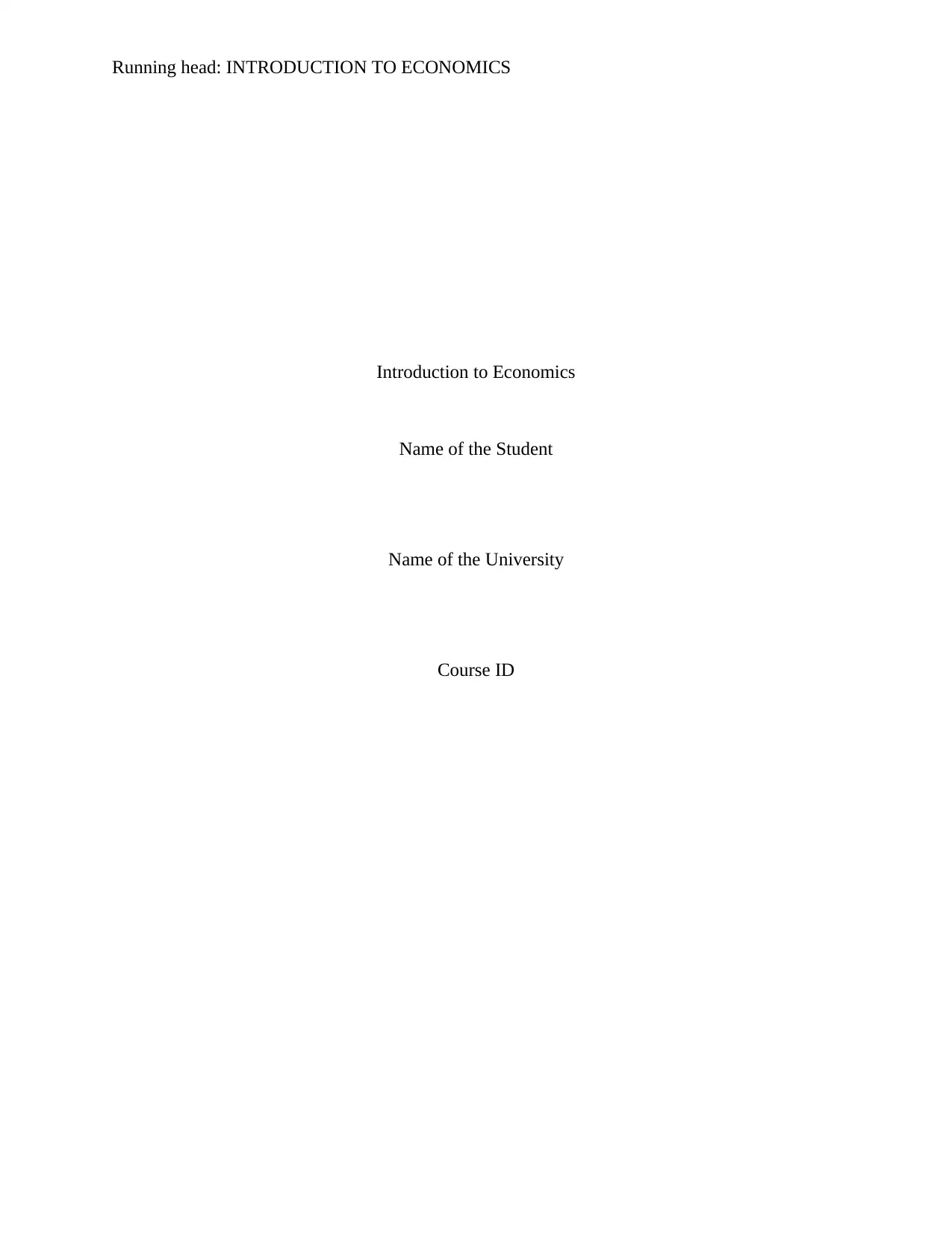
Running head: INTRODUCTION TO ECONOMICS
Introduction to Economics
Name of the Student
Name of the University
Course ID
Introduction to Economics
Name of the Student
Name of the University
Course ID
Paraphrase This Document
Need a fresh take? Get an instant paraphrase of this document with our AI Paraphraser
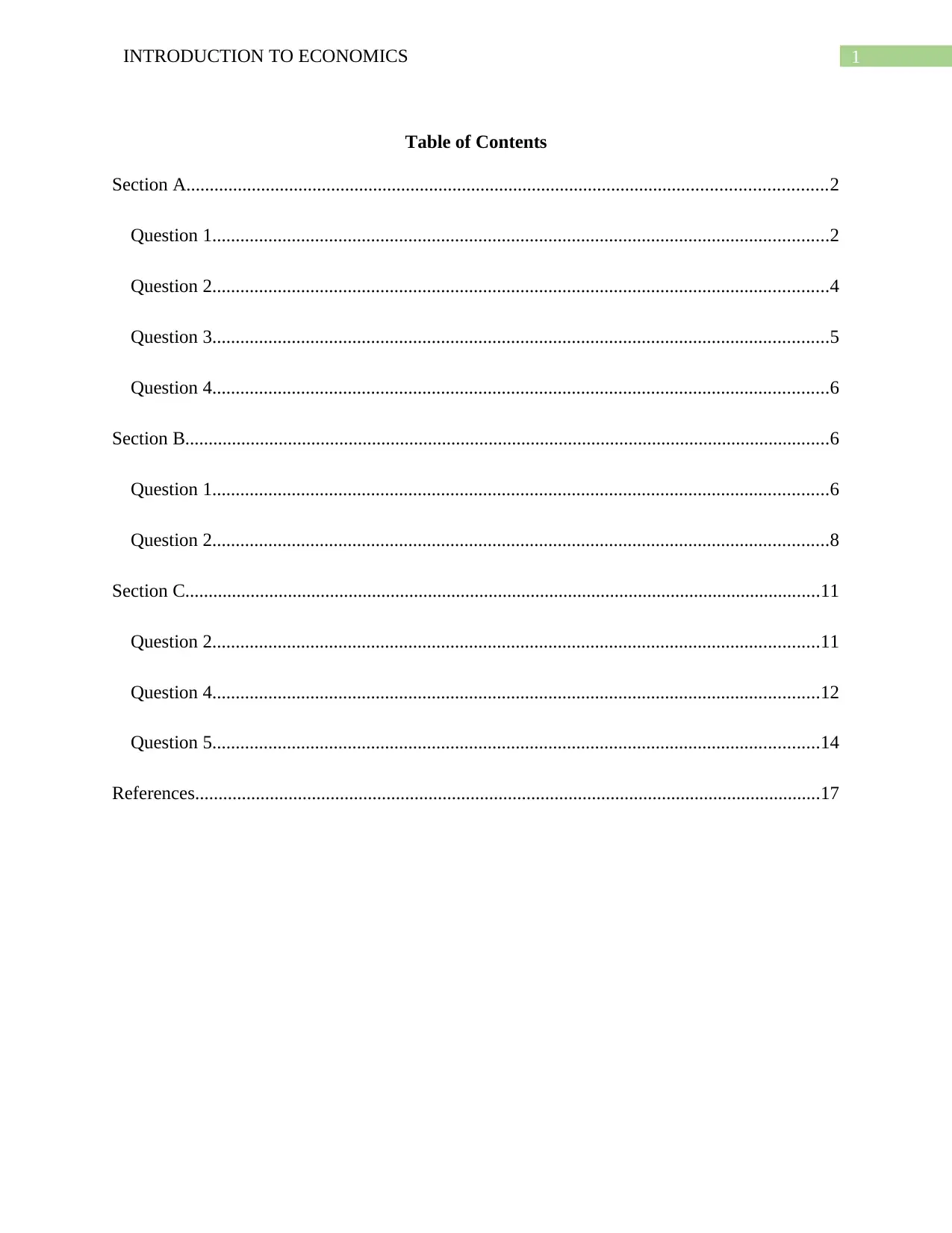
1INTRODUCTION TO ECONOMICS
Table of Contents
Section A.........................................................................................................................................2
Question 1....................................................................................................................................2
Question 2....................................................................................................................................4
Question 3....................................................................................................................................5
Question 4....................................................................................................................................6
Section B..........................................................................................................................................6
Question 1....................................................................................................................................6
Question 2....................................................................................................................................8
Section C........................................................................................................................................11
Question 2..................................................................................................................................11
Question 4..................................................................................................................................12
Question 5..................................................................................................................................14
References......................................................................................................................................17
Table of Contents
Section A.........................................................................................................................................2
Question 1....................................................................................................................................2
Question 2....................................................................................................................................4
Question 3....................................................................................................................................5
Question 4....................................................................................................................................6
Section B..........................................................................................................................................6
Question 1....................................................................................................................................6
Question 2....................................................................................................................................8
Section C........................................................................................................................................11
Question 2..................................................................................................................................11
Question 4..................................................................................................................................12
Question 5..................................................................................................................................14
References......................................................................................................................................17
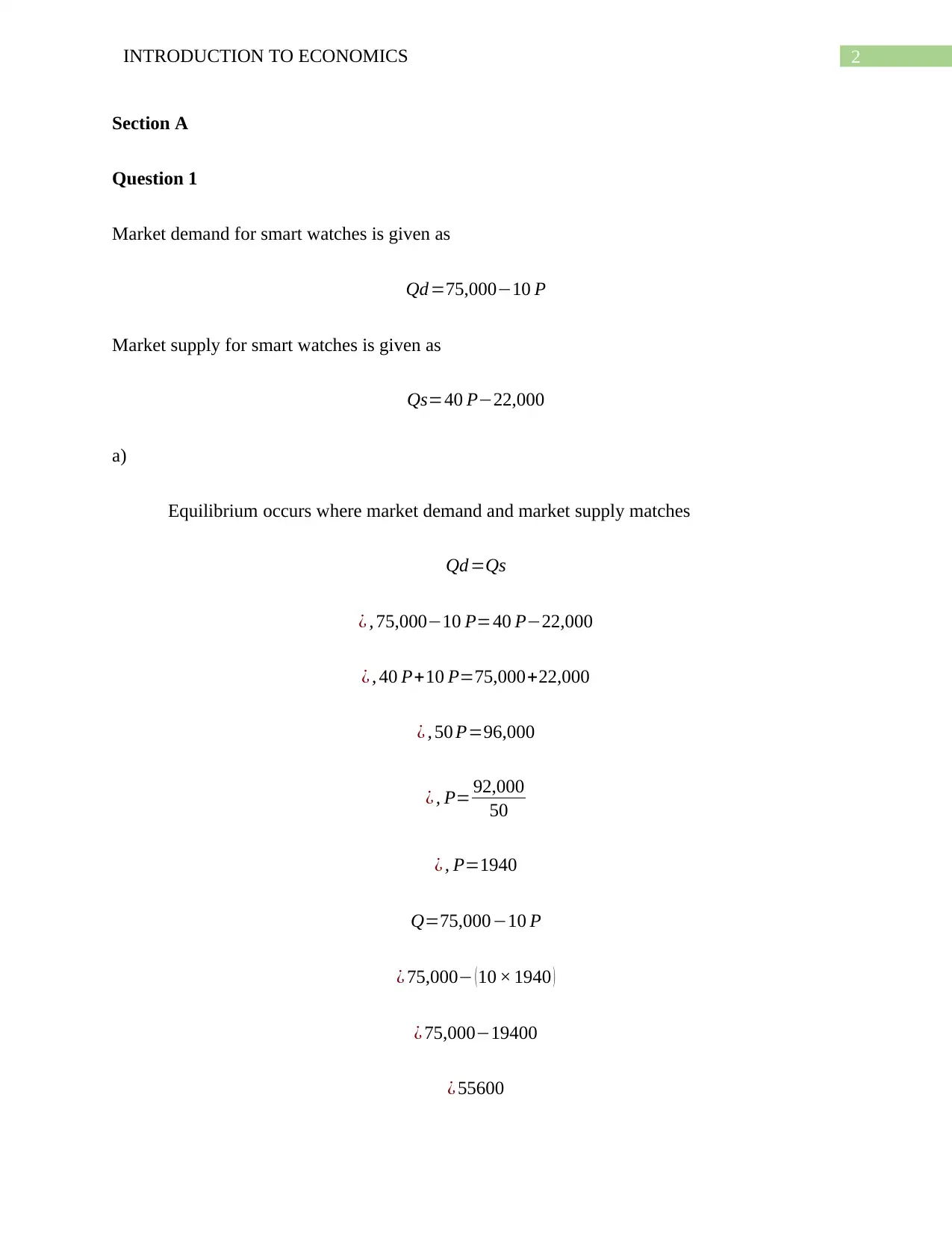
2INTRODUCTION TO ECONOMICS
Section A
Question 1
Market demand for smart watches is given as
Qd=75,000−10 P
Market supply for smart watches is given as
Qs=40 P−22,000
a)
Equilibrium occurs where market demand and market supply matches
Qd=Qs
¿ , 75,000−10 P=40 P−22,000
¿ , 40 P+10 P=75,000+22,000
¿ , 50 P=96,000
¿ , P= 92,000
50
¿ , P=1940
Q=75,000−10 P
¿ 75,000− (10 × 1940 )
¿ 75,000−19400
¿ 55600
Section A
Question 1
Market demand for smart watches is given as
Qd=75,000−10 P
Market supply for smart watches is given as
Qs=40 P−22,000
a)
Equilibrium occurs where market demand and market supply matches
Qd=Qs
¿ , 75,000−10 P=40 P−22,000
¿ , 40 P+10 P=75,000+22,000
¿ , 50 P=96,000
¿ , P= 92,000
50
¿ , P=1940
Q=75,000−10 P
¿ 75,000− (10 × 1940 )
¿ 75,000−19400
¿ 55600
⊘ This is a preview!⊘
Do you want full access?
Subscribe today to unlock all pages.

Trusted by 1+ million students worldwide
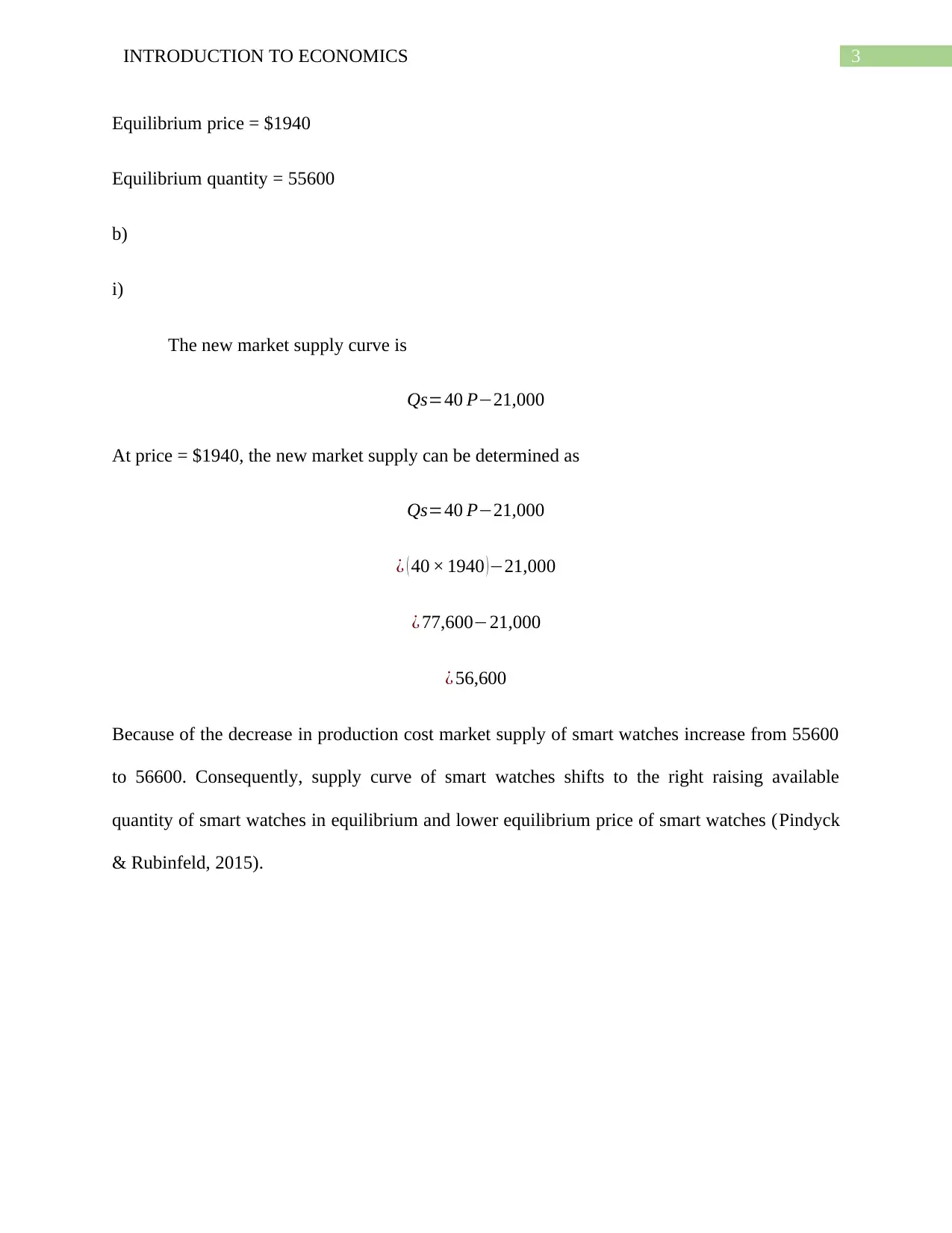
3INTRODUCTION TO ECONOMICS
Equilibrium price = $1940
Equilibrium quantity = 55600
b)
i)
The new market supply curve is
Qs=40 P−21,000
At price = $1940, the new market supply can be determined as
Qs=40 P−21,000
¿ ( 40 × 1940 ) −21,000
¿ 77,600−21,000
¿ 56,600
Because of the decrease in production cost market supply of smart watches increase from 55600
to 56600. Consequently, supply curve of smart watches shifts to the right raising available
quantity of smart watches in equilibrium and lower equilibrium price of smart watches (Pindyck
& Rubinfeld, 2015).
Equilibrium price = $1940
Equilibrium quantity = 55600
b)
i)
The new market supply curve is
Qs=40 P−21,000
At price = $1940, the new market supply can be determined as
Qs=40 P−21,000
¿ ( 40 × 1940 ) −21,000
¿ 77,600−21,000
¿ 56,600
Because of the decrease in production cost market supply of smart watches increase from 55600
to 56600. Consequently, supply curve of smart watches shifts to the right raising available
quantity of smart watches in equilibrium and lower equilibrium price of smart watches (Pindyck
& Rubinfeld, 2015).
Paraphrase This Document
Need a fresh take? Get an instant paraphrase of this document with our AI Paraphraser
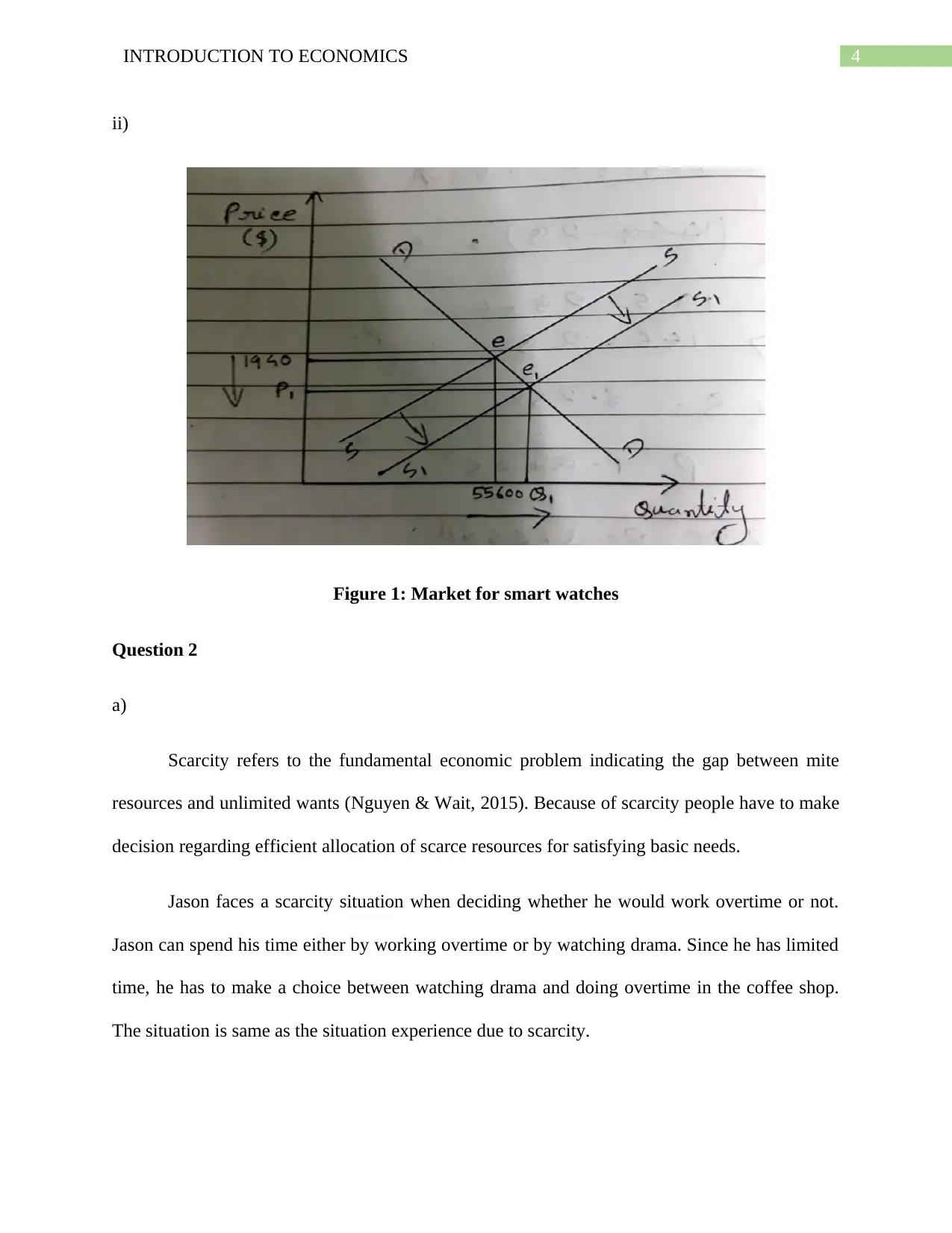
4INTRODUCTION TO ECONOMICS
ii)
Figure 1: Market for smart watches
Question 2
a)
Scarcity refers to the fundamental economic problem indicating the gap between mite
resources and unlimited wants (Nguyen & Wait, 2015). Because of scarcity people have to make
decision regarding efficient allocation of scarce resources for satisfying basic needs.
Jason faces a scarcity situation when deciding whether he would work overtime or not.
Jason can spend his time either by working overtime or by watching drama. Since he has limited
time, he has to make a choice between watching drama and doing overtime in the coffee shop.
The situation is same as the situation experience due to scarcity.
ii)
Figure 1: Market for smart watches
Question 2
a)
Scarcity refers to the fundamental economic problem indicating the gap between mite
resources and unlimited wants (Nguyen & Wait, 2015). Because of scarcity people have to make
decision regarding efficient allocation of scarce resources for satisfying basic needs.
Jason faces a scarcity situation when deciding whether he would work overtime or not.
Jason can spend his time either by working overtime or by watching drama. Since he has limited
time, he has to make a choice between watching drama and doing overtime in the coffee shop.
The situation is same as the situation experience due to scarcity.
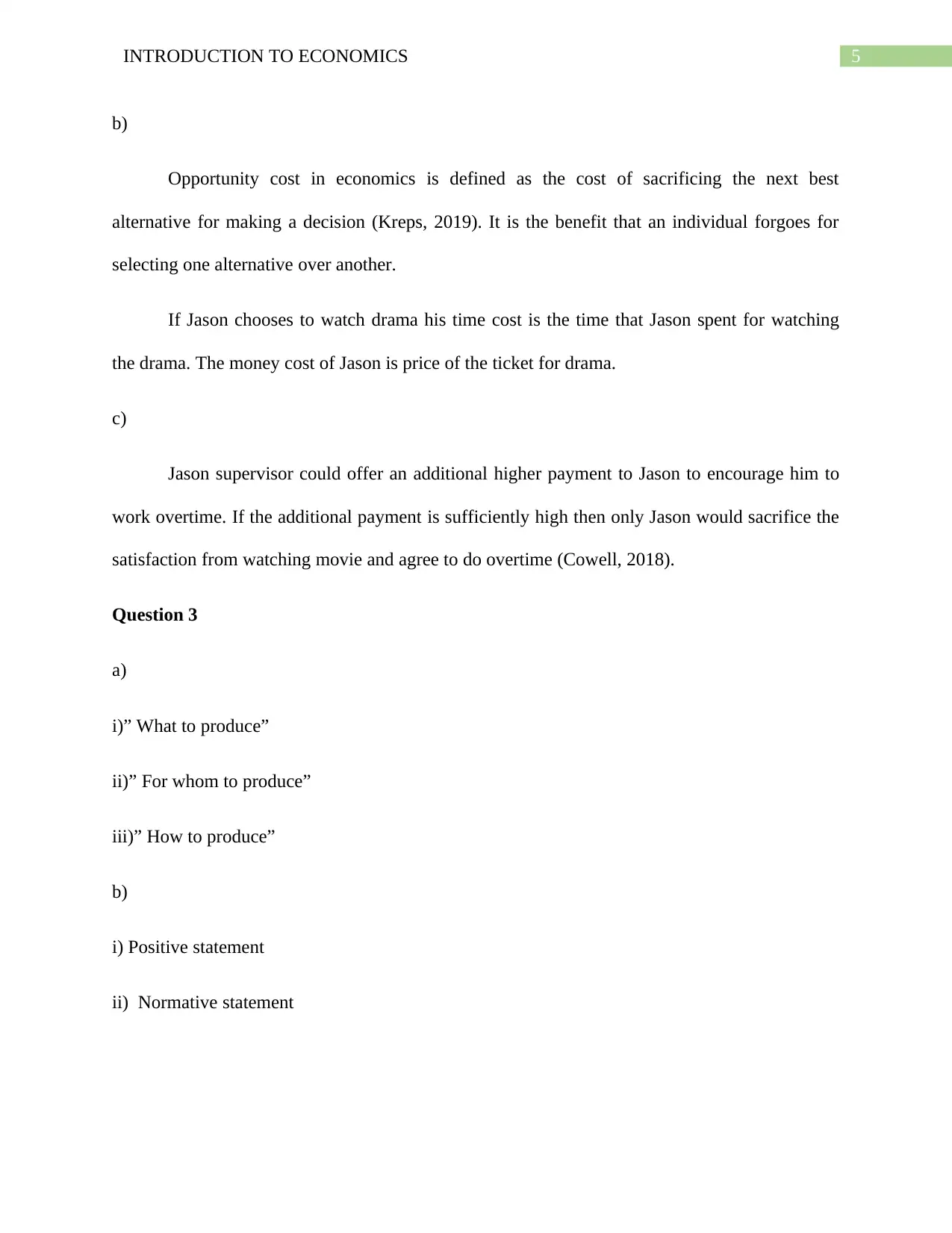
5INTRODUCTION TO ECONOMICS
b)
Opportunity cost in economics is defined as the cost of sacrificing the next best
alternative for making a decision (Kreps, 2019). It is the benefit that an individual forgoes for
selecting one alternative over another.
If Jason chooses to watch drama his time cost is the time that Jason spent for watching
the drama. The money cost of Jason is price of the ticket for drama.
c)
Jason supervisor could offer an additional higher payment to Jason to encourage him to
work overtime. If the additional payment is sufficiently high then only Jason would sacrifice the
satisfaction from watching movie and agree to do overtime (Cowell, 2018).
Question 3
a)
i)” What to produce”
ii)” For whom to produce”
iii)” How to produce”
b)
i) Positive statement
ii) Normative statement
b)
Opportunity cost in economics is defined as the cost of sacrificing the next best
alternative for making a decision (Kreps, 2019). It is the benefit that an individual forgoes for
selecting one alternative over another.
If Jason chooses to watch drama his time cost is the time that Jason spent for watching
the drama. The money cost of Jason is price of the ticket for drama.
c)
Jason supervisor could offer an additional higher payment to Jason to encourage him to
work overtime. If the additional payment is sufficiently high then only Jason would sacrifice the
satisfaction from watching movie and agree to do overtime (Cowell, 2018).
Question 3
a)
i)” What to produce”
ii)” For whom to produce”
iii)” How to produce”
b)
i) Positive statement
ii) Normative statement
⊘ This is a preview!⊘
Do you want full access?
Subscribe today to unlock all pages.

Trusted by 1+ million students worldwide
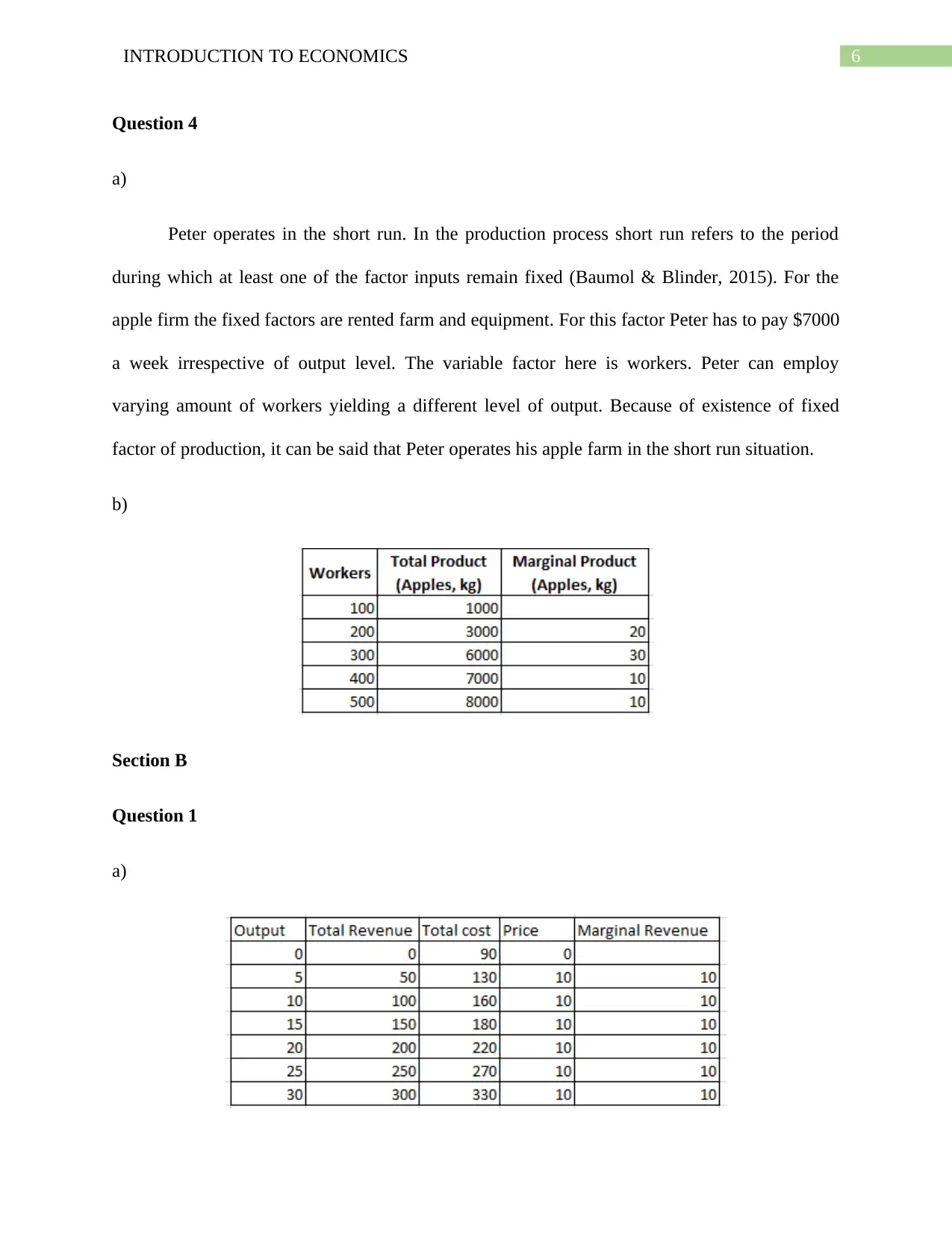
6INTRODUCTION TO ECONOMICS
Question 4
a)
Peter operates in the short run. In the production process short run refers to the period
during which at least one of the factor inputs remain fixed (Baumol & Blinder, 2015). For the
apple firm the fixed factors are rented farm and equipment. For this factor Peter has to pay $7000
a week irrespective of output level. The variable factor here is workers. Peter can employ
varying amount of workers yielding a different level of output. Because of existence of fixed
factor of production, it can be said that Peter operates his apple farm in the short run situation.
b)
Section B
Question 1
a)
Question 4
a)
Peter operates in the short run. In the production process short run refers to the period
during which at least one of the factor inputs remain fixed (Baumol & Blinder, 2015). For the
apple firm the fixed factors are rented farm and equipment. For this factor Peter has to pay $7000
a week irrespective of output level. The variable factor here is workers. Peter can employ
varying amount of workers yielding a different level of output. Because of existence of fixed
factor of production, it can be said that Peter operates his apple farm in the short run situation.
b)
Section B
Question 1
a)
Paraphrase This Document
Need a fresh take? Get an instant paraphrase of this document with our AI Paraphraser
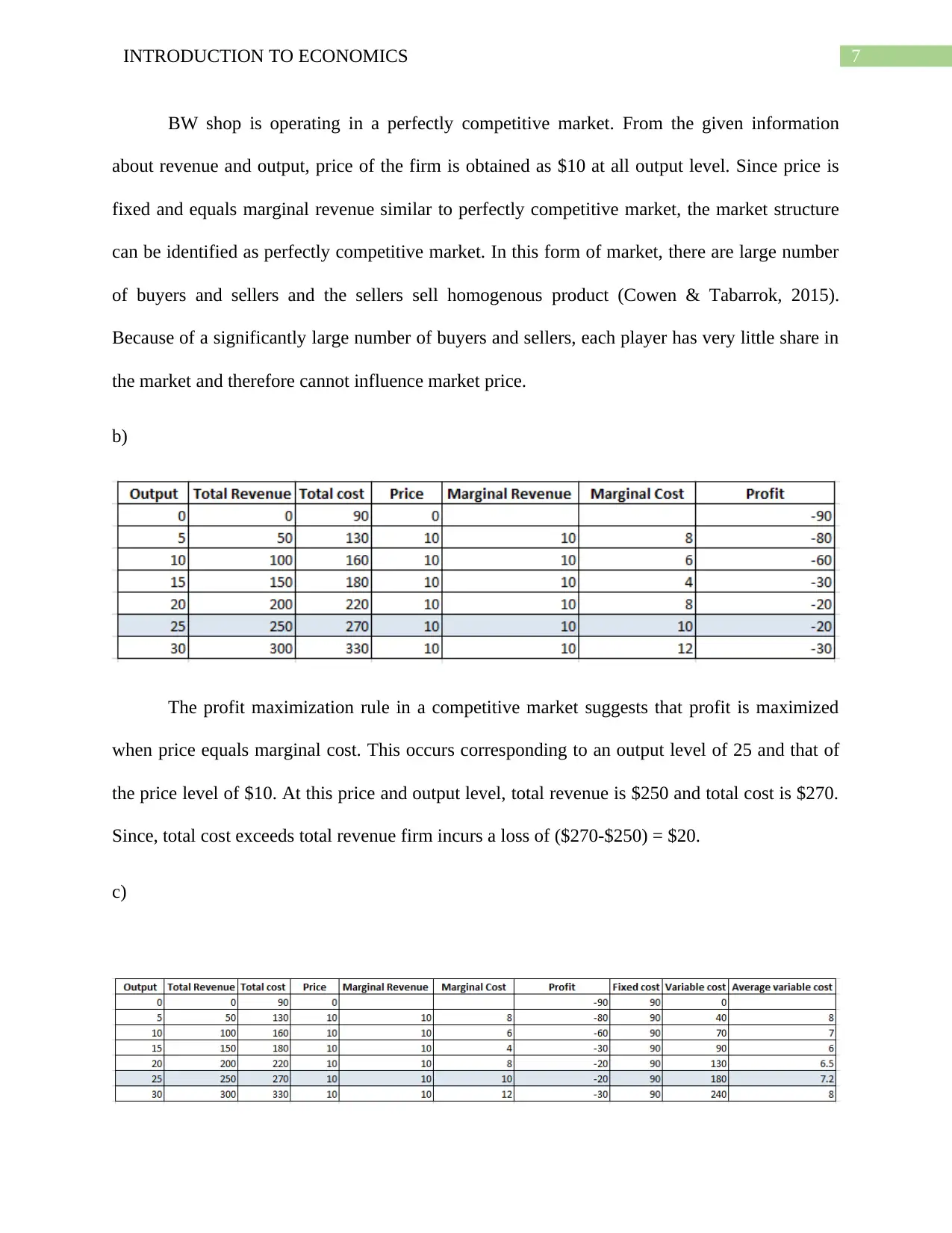
7INTRODUCTION TO ECONOMICS
BW shop is operating in a perfectly competitive market. From the given information
about revenue and output, price of the firm is obtained as $10 at all output level. Since price is
fixed and equals marginal revenue similar to perfectly competitive market, the market structure
can be identified as perfectly competitive market. In this form of market, there are large number
of buyers and sellers and the sellers sell homogenous product (Cowen & Tabarrok, 2015).
Because of a significantly large number of buyers and sellers, each player has very little share in
the market and therefore cannot influence market price.
b)
The profit maximization rule in a competitive market suggests that profit is maximized
when price equals marginal cost. This occurs corresponding to an output level of 25 and that of
the price level of $10. At this price and output level, total revenue is $250 and total cost is $270.
Since, total cost exceeds total revenue firm incurs a loss of ($270-$250) = $20.
c)
BW shop is operating in a perfectly competitive market. From the given information
about revenue and output, price of the firm is obtained as $10 at all output level. Since price is
fixed and equals marginal revenue similar to perfectly competitive market, the market structure
can be identified as perfectly competitive market. In this form of market, there are large number
of buyers and sellers and the sellers sell homogenous product (Cowen & Tabarrok, 2015).
Because of a significantly large number of buyers and sellers, each player has very little share in
the market and therefore cannot influence market price.
b)
The profit maximization rule in a competitive market suggests that profit is maximized
when price equals marginal cost. This occurs corresponding to an output level of 25 and that of
the price level of $10. At this price and output level, total revenue is $250 and total cost is $270.
Since, total cost exceeds total revenue firm incurs a loss of ($270-$250) = $20.
c)
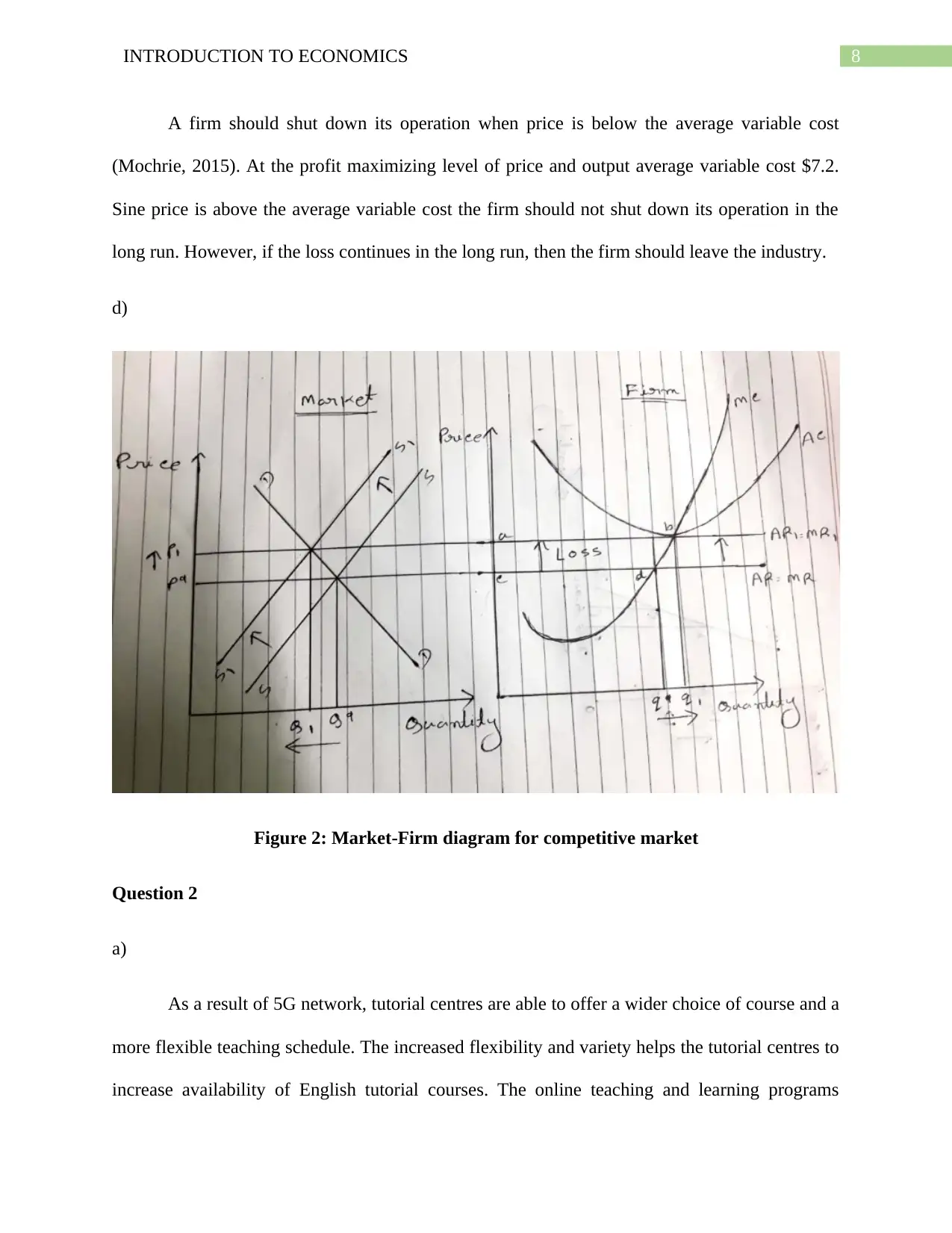
8INTRODUCTION TO ECONOMICS
A firm should shut down its operation when price is below the average variable cost
(Mochrie, 2015). At the profit maximizing level of price and output average variable cost $7.2.
Sine price is above the average variable cost the firm should not shut down its operation in the
long run. However, if the loss continues in the long run, then the firm should leave the industry.
d)
Figure 2: Market-Firm diagram for competitive market
Question 2
a)
As a result of 5G network, tutorial centres are able to offer a wider choice of course and a
more flexible teaching schedule. The increased flexibility and variety helps the tutorial centres to
increase availability of English tutorial courses. The online teaching and learning programs
A firm should shut down its operation when price is below the average variable cost
(Mochrie, 2015). At the profit maximizing level of price and output average variable cost $7.2.
Sine price is above the average variable cost the firm should not shut down its operation in the
long run. However, if the loss continues in the long run, then the firm should leave the industry.
d)
Figure 2: Market-Firm diagram for competitive market
Question 2
a)
As a result of 5G network, tutorial centres are able to offer a wider choice of course and a
more flexible teaching schedule. The increased flexibility and variety helps the tutorial centres to
increase availability of English tutorial courses. The online teaching and learning programs
⊘ This is a preview!⊘
Do you want full access?
Subscribe today to unlock all pages.

Trusted by 1+ million students worldwide
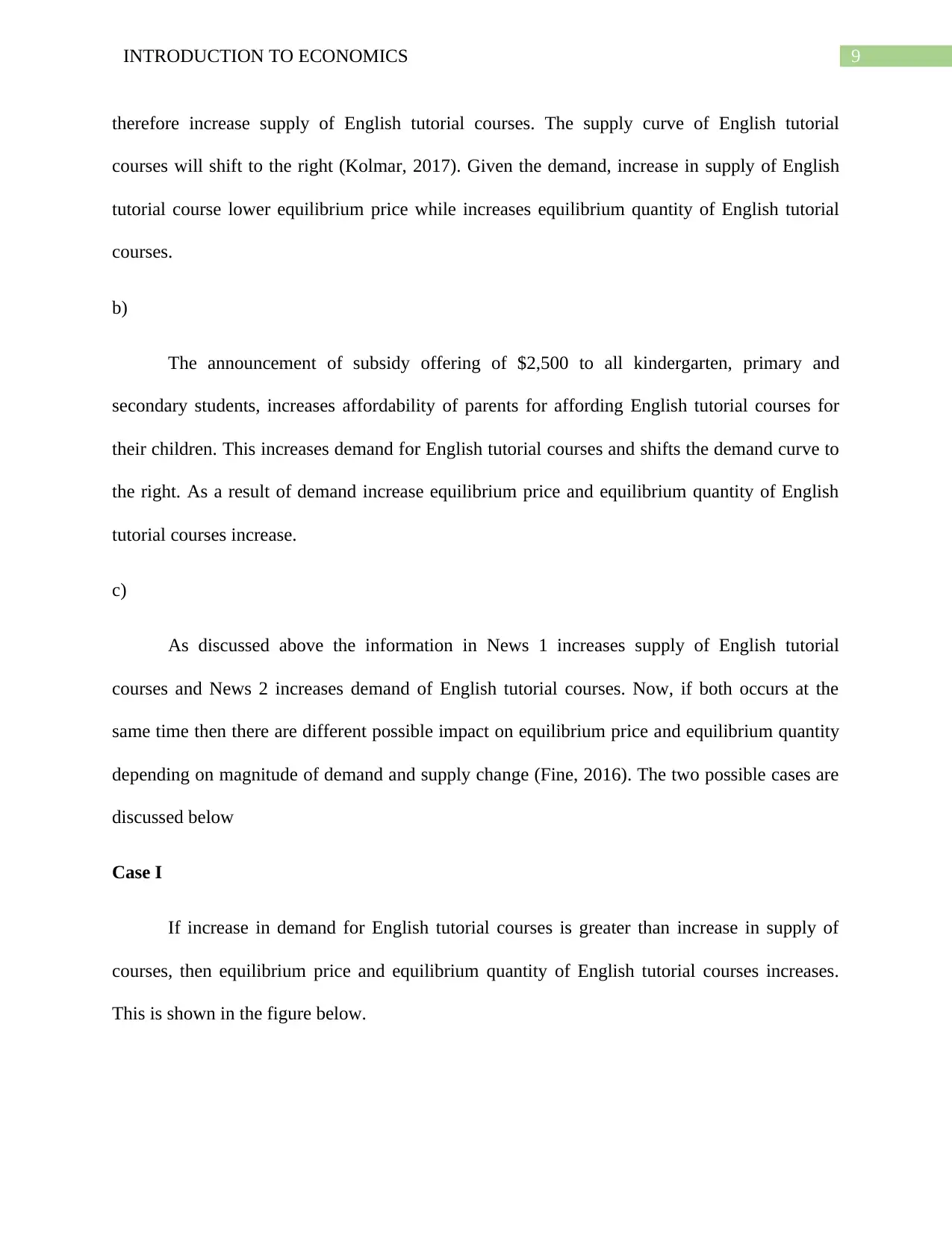
9INTRODUCTION TO ECONOMICS
therefore increase supply of English tutorial courses. The supply curve of English tutorial
courses will shift to the right (Kolmar, 2017). Given the demand, increase in supply of English
tutorial course lower equilibrium price while increases equilibrium quantity of English tutorial
courses.
b)
The announcement of subsidy offering of $2,500 to all kindergarten, primary and
secondary students, increases affordability of parents for affording English tutorial courses for
their children. This increases demand for English tutorial courses and shifts the demand curve to
the right. As a result of demand increase equilibrium price and equilibrium quantity of English
tutorial courses increase.
c)
As discussed above the information in News 1 increases supply of English tutorial
courses and News 2 increases demand of English tutorial courses. Now, if both occurs at the
same time then there are different possible impact on equilibrium price and equilibrium quantity
depending on magnitude of demand and supply change (Fine, 2016). The two possible cases are
discussed below
Case I
If increase in demand for English tutorial courses is greater than increase in supply of
courses, then equilibrium price and equilibrium quantity of English tutorial courses increases.
This is shown in the figure below.
therefore increase supply of English tutorial courses. The supply curve of English tutorial
courses will shift to the right (Kolmar, 2017). Given the demand, increase in supply of English
tutorial course lower equilibrium price while increases equilibrium quantity of English tutorial
courses.
b)
The announcement of subsidy offering of $2,500 to all kindergarten, primary and
secondary students, increases affordability of parents for affording English tutorial courses for
their children. This increases demand for English tutorial courses and shifts the demand curve to
the right. As a result of demand increase equilibrium price and equilibrium quantity of English
tutorial courses increase.
c)
As discussed above the information in News 1 increases supply of English tutorial
courses and News 2 increases demand of English tutorial courses. Now, if both occurs at the
same time then there are different possible impact on equilibrium price and equilibrium quantity
depending on magnitude of demand and supply change (Fine, 2016). The two possible cases are
discussed below
Case I
If increase in demand for English tutorial courses is greater than increase in supply of
courses, then equilibrium price and equilibrium quantity of English tutorial courses increases.
This is shown in the figure below.
Paraphrase This Document
Need a fresh take? Get an instant paraphrase of this document with our AI Paraphraser
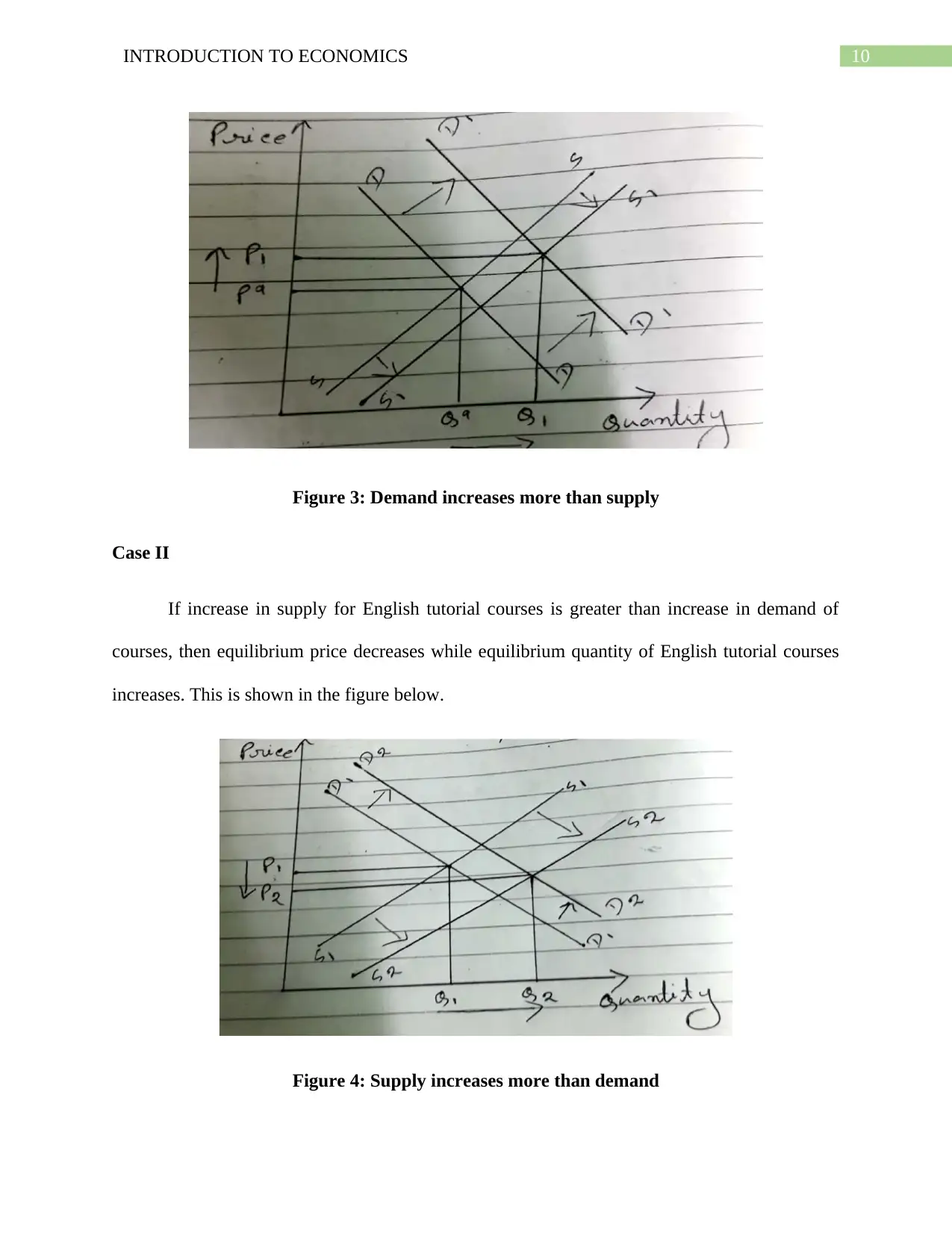
10INTRODUCTION TO ECONOMICS
Figure 3: Demand increases more than supply
Case II
If increase in supply for English tutorial courses is greater than increase in demand of
courses, then equilibrium price decreases while equilibrium quantity of English tutorial courses
increases. This is shown in the figure below.
Figure 4: Supply increases more than demand
Figure 3: Demand increases more than supply
Case II
If increase in supply for English tutorial courses is greater than increase in demand of
courses, then equilibrium price decreases while equilibrium quantity of English tutorial courses
increases. This is shown in the figure below.
Figure 4: Supply increases more than demand
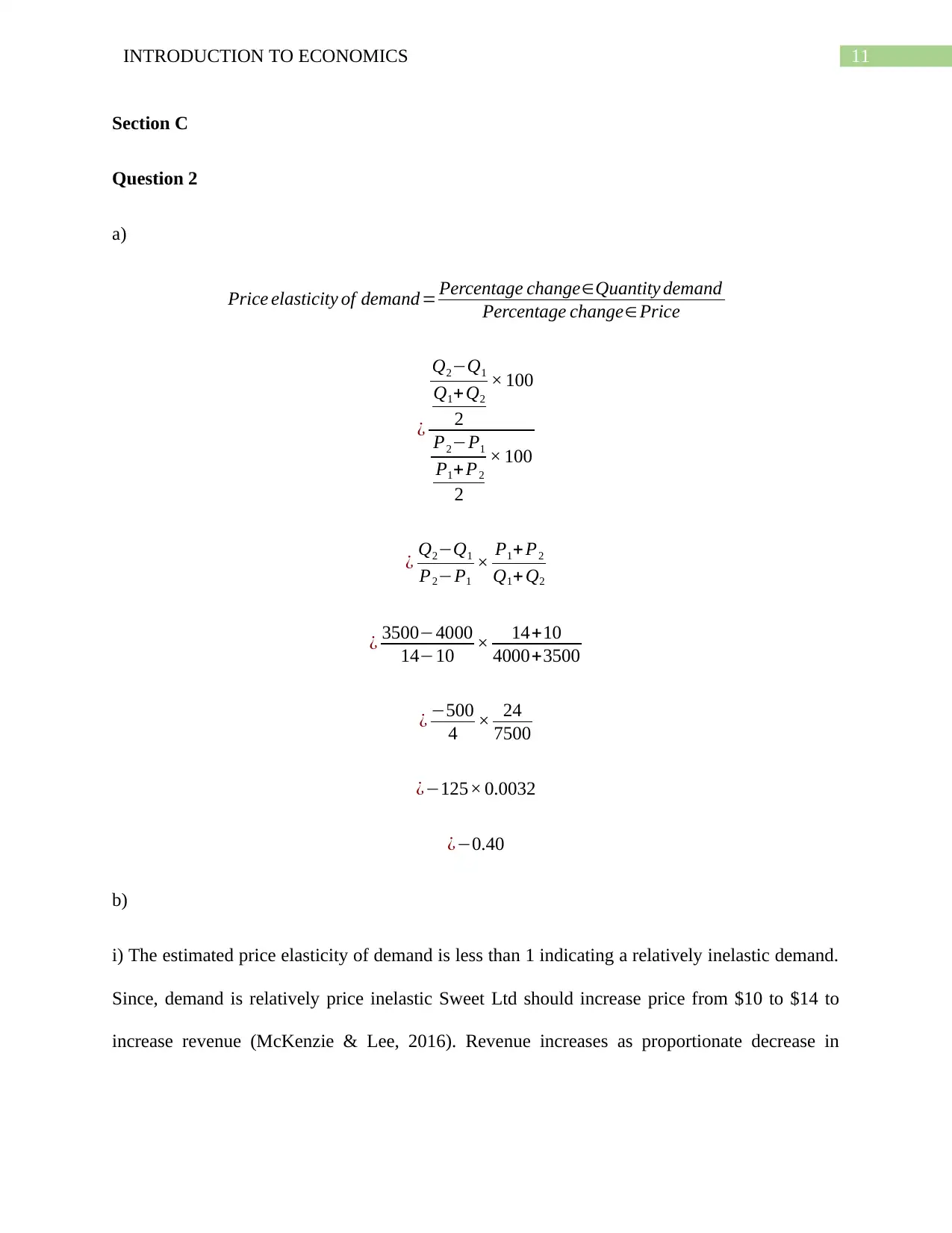
11INTRODUCTION TO ECONOMICS
Section C
Question 2
a)
Price elasticity of demand= Percentage change∈Quantity demand
Percentage change∈Price
¿
Q2−Q1
Q1+ Q2
2
× 100
P2−P1
P1+ P2
2
× 100
¿ Q2−Q1
P2−P1
× P1+ P2
Q1+ Q2
¿ 3500−4000
14−10 × 14+10
4000+3500
¿ −500
4 × 24
7500
¿−125× 0.0032
¿−0.40
b)
i) The estimated price elasticity of demand is less than 1 indicating a relatively inelastic demand.
Since, demand is relatively price inelastic Sweet Ltd should increase price from $10 to $14 to
increase revenue (McKenzie & Lee, 2016). Revenue increases as proportionate decrease in
Section C
Question 2
a)
Price elasticity of demand= Percentage change∈Quantity demand
Percentage change∈Price
¿
Q2−Q1
Q1+ Q2
2
× 100
P2−P1
P1+ P2
2
× 100
¿ Q2−Q1
P2−P1
× P1+ P2
Q1+ Q2
¿ 3500−4000
14−10 × 14+10
4000+3500
¿ −500
4 × 24
7500
¿−125× 0.0032
¿−0.40
b)
i) The estimated price elasticity of demand is less than 1 indicating a relatively inelastic demand.
Since, demand is relatively price inelastic Sweet Ltd should increase price from $10 to $14 to
increase revenue (McKenzie & Lee, 2016). Revenue increases as proportionate decrease in
⊘ This is a preview!⊘
Do you want full access?
Subscribe today to unlock all pages.

Trusted by 1+ million students worldwide
1 out of 18
Related Documents
Your All-in-One AI-Powered Toolkit for Academic Success.
+13062052269
info@desklib.com
Available 24*7 on WhatsApp / Email
![[object Object]](/_next/static/media/star-bottom.7253800d.svg)
Unlock your academic potential
Copyright © 2020–2025 A2Z Services. All Rights Reserved. Developed and managed by ZUCOL.





